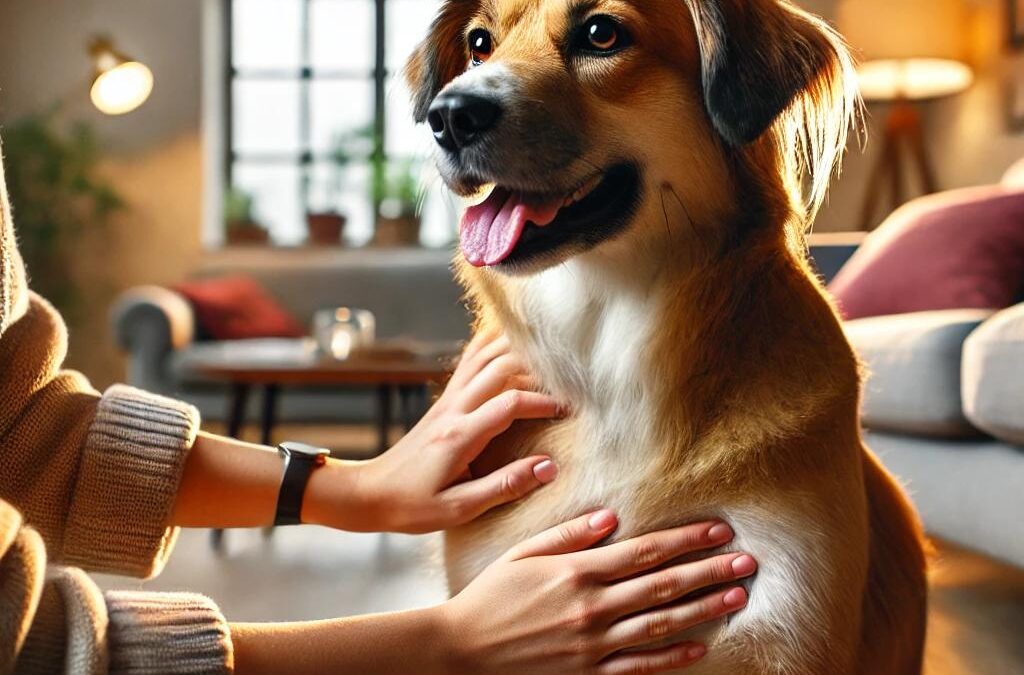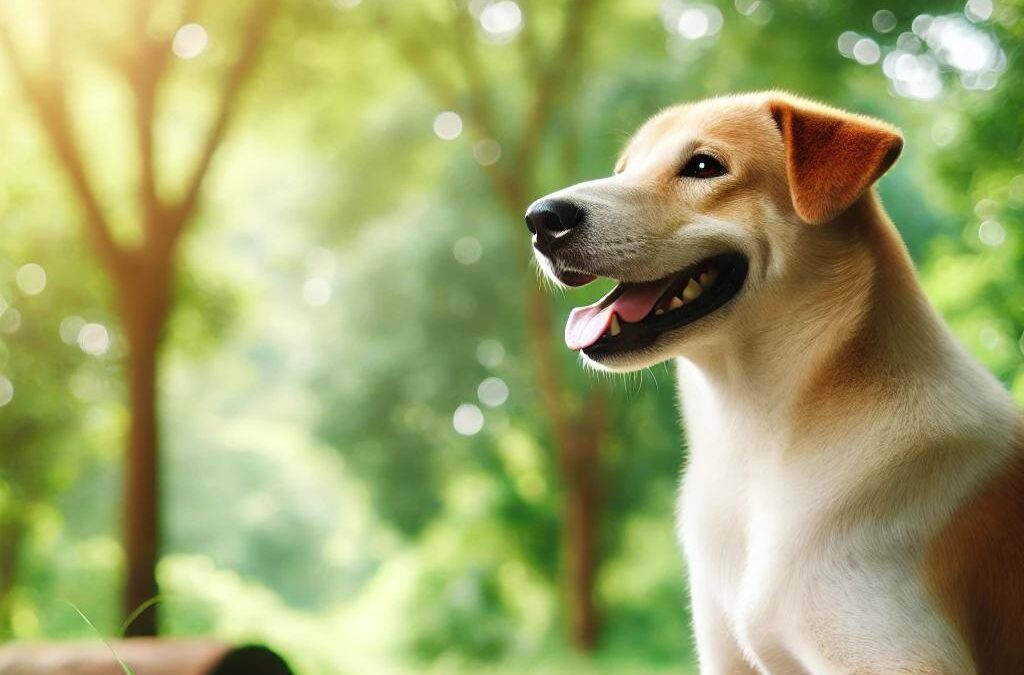
에 의해 TCMVET | 2024년 10월 14일 | 개 암 및 종양
Ear tumors in dogs can develop in any part of the ear, from the outer pinna to the deeper sections of the ear canal and inner ear. While some ear tumors are benign and grow slowly without spreading, others are malignant and require immediate medical attention. Understanding the signs of ear tumors and knowing what to watch for can help you catch any issues early and improve your dog’s chances of successful treatment.
What Are Ear Tumors?
Ear tumors refer to abnormal growths that appear in or around a dog’s ear. Not all tumors are cancerous, but they should still be closely monitored and evaluated by a veterinarian. Ear cancer is a specific type of ear tumor that is malignant, meaning it grows aggressively and may spread to other parts of the body. Tumors in the ear can affect the pinna (outer ear), the ear canal, the middle ear, and even the inner ear.
Common Areas Where Ear Tumors Develop
- Pinna (Outer Ear)
The pinna, or outer flap of the ear, is more commonly affected by ear tumors, especially in dogs with droopy ears or ears that are exposed to the sun for long periods. Tumors here are often easier to detect during grooming or petting.
- External Ear Canal
The external ear canal is the passage leading into the ear that contains both a vertical and horizontal section. Tumors here may cause symptoms like head shaking, scratching, or visible swelling.
- Middle Ear
The middle ear, located behind the eardrum, contains small bones that transmit sound. Tumors in this area can affect a dog’s hearing and balance, causing more serious symptoms like head tilting or difficulty walking.
- Inner Ear
The inner ear controls hearing and balance. While tumors in this region are rare, they can cause severe balance issues and neurological symptoms if they occur.
Signs and Symptoms of Ear Tumors in Dogs
It’s important for pet owners to recognize the signs of ear tumors early. Common symptoms include:
- 머리를 흔들거나 긁는다: Persistent head shaking or pawing at the ear may indicate irritation caused by a tumor.
- Discharge or foul smell: Tumors can lead to an infection, causing foul-smelling discharge from the ear.
- Visible lumps or swelling: Growths on the pinna or near the ear canal can be seen or felt, especially during grooming.
- 청력 상실: Tumors affecting the ear canal or middle ear can block sound, leading to partial or complete hearing loss.
- Balance issues: If a tumor affects the inner ear, your dog may experience problems with balance, such as wobbling or falling.
Diagnosing Ear Tumors in Dogs
If you notice any unusual symptoms in your dog’s ears, it’s important to consult a veterinarian as soon as possible. Your vet may perform a physical exam, imaging tests (such as X-rays or CT scans), and a biopsy to determine whether the tumor is benign or malignant. Early diagnosis can help ensure the best treatment options are available.
치료 옵션
Treatment for ear tumors depends on whether the tumor is benign or malignant:
- Benign tumors can often be surgically removed if they are causing discomfort or obstructing the ear canal.
- Malignant tumors may require more aggressive treatment, including surgery, radiation therapy, or chemotherapy. In severe cases, partial or full removal of the affected ear may be necessary to prevent the spread of cancer.
Ear tumors in dogs, whether benign or malignant, should never be ignored. Regularly check your dog’s ears for any lumps, swelling, or unusual symptoms. If you notice any changes in your dog’s behavior or ear health, contact your veterinarian for a thorough evaluation. Early detection is key to improving outcomes, especially for malignant ear tumors.

에 의해 TCMVET | 2024년 10월 14일 | 개 암 및 종양
Veterinarians are highly trained to spot abnormalities in your dog or cat, and regular veterinary check-ups are essential for catching serious health issues, such as cancer. However, most pets only visit the vet once or twice a year, leaving gaps in monitoring. As a pet owner, you can play an active role in your pet’s health by performing routine at-home checks to detect potential signs of cancer early.
The Importance of At-Home Health Checks for Pets
While annual vet visits are crucial, you are in the best position to notice subtle changes in your pet’s health. By incorporating monthly at-home health checks into your routine, you can spot lumps, weight changes, and other signs of illness before they become more serious. Early detection can lead to earlier treatment, giving your pet a better chance at a positive outcome.
How to Check for Lumps and Bumps
One of the easiest and most important things you can do during an at-home check is to feel for lumps and bumps. Run your hands slowly over your pet’s entire body, paying special attention to the chest, belly, and limbs. Don’t forget to check between the toes and under the armpits. For female pets, make sure to inspect the nipples and surrounding tissues for any lumps or swelling, as mammary tumors are common in dogs and cats.
Monitoring Weight and Body Condition
Weight loss or gain can be a subtle sign of cancer in pets. Run your hands along your pet’s rib cage to feel for any unusual changes in body condition. You should be able to feel your pet’s ribs without pressing too hard, but they shouldn’t be overly prominent. To monitor weight trends more accurately, weigh your pet monthly and keep a log. This allows you to spot gradual changes that might otherwise go unnoticed.
Oral Health Checks
Your pet’s mouth can reveal a lot about their overall health. Regularly look inside your pet’s mouth to check their teeth, gums, and tongue. Lift the lips to inspect the gum line and teeth for any unusual growths, discoloration, or bleeding. To make this process easier, offer a treat and let your pet lick it while you check the top and bottom of the tongue for any abnormal lumps or sores.
The Role of Pet Owners in Cancer Detection
You know your pet better than anyone else, and by incorporating monthly at-home health checks, you increase the likelihood of catching any subtle signs of cancer early. If you detect anything unusual, such as a new lump, unexplained weight loss, or abnormal behavior, schedule a visit with your veterinarian for further evaluation.
Regular at-home health checks can be a powerful tool in detecting early signs of cancer in pets. By staying proactive and monitoring your pet’s health closely, you can catch potential issues before they worsen. Along with annual veterinary exams, these routine checks give your pet the best chance at maintaining a healthy, happy life.

에 의해 TCMVET | 2024년 10월 14일 | 개 암 및 종양
암은 반려동물 사망의 주요 원인이지만, 초기 경고 신호 중 많은 부분은 놓치기 쉽습니다. 체중 감소나 큰 덩어리와 같은 명백한 증상과 달리, 미묘한 지표는 반려동물 주인이 종종 알아차리지 못해 진단과 치료가 늦어질 수 있습니다. 이러한 미묘한 징후를 알고 있으면 암을 조기에 발견하고 반려동물의 예후를 개선하는 데 큰 차이를 만들 수 있습니다.
애완동물의 흔하지만 간과되는 암 징후
- 식습관의 변화
애완동물이 갑자기 까다롭게 먹거나 식욕이 급격하게 변하면 암의 조기 징후일 수 있습니다. 위장계, 입 또는 목에 영향을 미치는 종양은 불편함이나 식사 어려움을 유발할 수 있습니다. 애완동물이 다른 음식보다 특정 음식을 더 선호하는 것처럼 보이더라도 식사 패턴을 면밀히 모니터링하는 것이 중요합니다.
- 무기력함과 설명할 수 없는 피로
갑자기 에너지가 부족하거나 규칙적인 활동에 참여하기를 꺼리는 것은 암의 초기 징후일 수 있습니다. 많은 애완동물 주인이 이를 노화로 돌릴 수 있지만, 지속적인 피로나 활동 수준 감소는 암을 포함한 근본적인 건강 문제를 나타낼 수 있습니다.
- 비정상적인 덩어리 또는 부기
모든 덩어리가 쉽게 눈에 띄는 것은 아니며, 특히 털이 두꺼운 애완동물의 경우 더욱 그렇습니다. 피부 아래나 손이 닿기 어려운 부위(예: 발가락 사이 또는 꼬리)에 생기는 붓기는 눈에 띄지 않을 수 있습니다. 애완동물의 몸을 정기적으로 확인하여 비정상적인 성장이 있는지 확인하는 것이 중요합니다.
- 체중 감량 또는 증가
예상치 못한 체중 감소는 애완동물 암의 가장 명확한 징후 중 하나일 수 있습니다. 그러나 일부 애완동물 주인은 이 증상을 간과할 수 있으며, 특히 체중 변화가 덜 눈에 띄는 장모 애완동물의 경우 더욱 그렇습니다. 반면에 특정 종양은 체액 유지로 이어져 갑자기 체중이 증가할 수 있습니다.
- 지속적인 기침 또는 호흡곤란
만성 기침, 특히 호흡기 감염과 관련이 없는 것 같은 기침은 암, 특히 폐암의 미묘한 징후일 수 있습니다. 반려동물이 호흡곤란을 호소하거나 건조하고 비생산적인 기침을 하는 경우 수의사 진찰을 받는 것이 중요합니다.
- 욕실 습관의 변화
소화계나 방광의 암은 반려동물의 변기 습관에 변화를 일으킬 수 있습니다. 지속적인 설사, 변비, 대변에 혈액이 섞여 있거나 소변을 보는 데 어려움이 있는지 살펴보세요. 이러한 변화는 미묘할 수 있지만 더 심각한 기저 질환을 나타낼 수 있습니다.
- 구취 또는 구강 불편감
애완동물의 구취는 종종 치과 질환과 관련이 있지만, 구강 종양의 징후일 수도 있습니다. 애완동물이 입 통증, 과도한 침흘림 또는 잇몸 출혈의 징후를 보인다면 암 가능성을 배제하기 위해 더 자세히 조사할 가치가 있습니다.
- 치유되지 않는 상처
애완동물에게 치유하는 데 비정상적으로 오랜 시간이 걸리는 궤양이나 상처가 있다면 암의 징후일 수 있습니다. 지속적인 상처나 감염은 질병으로 인해 약해진 면역 체계의 결과일 수 있습니다.
- 행동 변화
평소에 친절하고 사교적인 애완동물이 소극적이거나, 짜증이 나거나, 공격적으로 변하면 불편함이나 고통의 신호일 수 있습니다. 행동 변화는 암을 포함한 내부 문제의 초기 지표일 수 있습니다.
조기 발견이 중요한 이유
애완동물의 암을 일찍 발견하면 치료 옵션과 결과를 크게 개선할 수 있습니다. 정기적인 검진과 애완동물의 건강을 정기적으로 모니터링하는 것은 질병이 진행되기 전에 잠재적인 경고 신호를 포착하는 데 중요합니다. 애완동물에게 이러한 미묘한 변화가 나타나면 추가 검사와 테스트를 위해 수의사와 상담하는 것이 필수적입니다.
많은 애완동물 주인들은 애완동물의 미묘한 암 징후를 간과하고, 종종 노화나 사소한 건강 문제로 인한 변화로 돌립니다. 경계하고 행동, 식욕 또는 신체 상태의 작은 변화에 주의를 기울이면 암을 조기에 발견하고 치료하여 애완동물의 생명을 구할 수 있습니다.

에 의해 TCMVET | 2024년 10월 14일 | 개 암 및 종양
반려견의 발은 정기 검진에서 간과되는 경우가 많지만, 다양한 종류의 성장과 종양이 생길 수 있는 부위입니다. 반려견의 발에 종양이나 비정상적인 덩어리가 생기면 우려할 만한 일이 될 수 있으며, 수의사가 평가하여 반려동물의 건강을 확인해야 합니다. 반려견의 발을 정기적으로 검사하면 이러한 문제를 일찍 발견하여 불편함과 잠재적인 합병증을 예방하는 데 도움이 될 수 있습니다.
개 발에서 흔히 발견되는 종양 유형
개의 발에는 양성에서 악성까지 다양한 종류의 종양이 생길 수 있습니다. 여기에는 다음이 포함됩니다.
- 흑색종: 더 심각한 종양 중 하나인 흑색종은 종종 검은색으로 보이고 손톱 밑 주변에서 자주 발견됩니다. 이 종양은 신체의 다른 부위로 퍼질 수 있으므로 조기 발견이 중요합니다.
- 비만 세포 종양: 이러한 성장은 분홍색 또는 빨간색일 수 있으며 궤양이 생기거나 벗겨진 것처럼 보일 수 있습니다. 비만세포 종양은 양성에서 매우 공격적인 형태까지 심각도가 다양할 수 있으므로 새로운 덩어리는 수의사가 검사해야 합니다.
- 편평 세포 암종: 이 유형의 암은 일반적으로 발가락 사이 부위에 영향을 미치며 사마귀나 딱지와 유사할 수 있습니다. 이러한 종양은 느리게 자라는 경향이 있지만 여전히 근처 조직을 침범할 수 있으므로 신속한 치료가 중요합니다.
- 양성 종양: 개 발의 모든 성장이 암은 아닙니다. 사마귀나 낭종은 비교적 흔하고 일반적으로 무해하지만 더 심각한 문제를 배제하기 위해 여전히 검사해야 합니다.
강아지 발에서 주의해야 할 징후
반려견의 발을 정기적으로 검사하면 변화를 일찍 감지할 수 있습니다. 반려견의 발에 종양이나 다른 성장이 있음을 나타낼 수 있는 몇 가지 징후는 다음과 같습니다.
- 발가락 사이가 부어오르거나 덩어리가 생김
- 변색이나 변형 등 손톱 이상
- 발을 만지면 통증이나 민감함
- 절뚝거리거나 걷는 것을 꺼려함
- 눈에 보이는 상처, 출혈 또는 분비물
수의학적 주의가 중요한 이유
일부 덩어리는 무해해 보일 수 있지만, 반려견의 건강에 관해서는 항상 조심하는 편이 좋습니다. 수의사는 생검이나 다른 검사를 통해 성장이 양성인지 악성인지 확인할 수 있습니다. 조기에 발견하고 진단하면 더 효과적인 치료 옵션을 얻을 수 있으며, 반려견을 불필요한 통증이나 더 심각한 건강 위험으로부터 구할 수 있습니다.
치료 옵션
발 종양의 치료는 진단에 따라 다를 수 있습니다. 양성 종양의 경우 수의사는 모니터링이나 간단한 제거를 권장할 수 있습니다. 반면 악성 종양은 수술, 화학 요법 또는 방사선 요법과 같은 보다 공격적인 치료가 필요할 수 있습니다. 어떤 경우에는 종양이 퍼지거나 심각한 손상을 입히는 경우 추가 합병증을 예방하기 위해 영향을 받은 부위를 절단하는 것이 고려될 수 있습니다.
반려견의 발을 정기적으로 검사하는 것은 반려동물을 건강하고 편안하게 유지하는 간단하면서도 효과적인 방법입니다. 새로운 덩어리나 비정상적인 성장이 보이면 수의사에게 진찰을 받는 것이 필수적입니다. 조기에 발견하고 치료하면 결과가 개선되고 반려견이 길고 행복한 삶을 누리는 데 도움이 될 수 있습니다.

에 의해 TCMVET | 2024년 10월 13일 | 개 암 및 종양
후두, 인두, 편도선과 같은 부위에 영향을 미치는 개의 인후 종양은 개의 먹고, 숨쉬고, 발성하는 능력에 상당한 영향을 미칠 수 있습니다. 양성이든 악성이든 이러한 종양은 증상을 관리하고 개의 삶의 질을 개선하기 위해 조기에 인식하고 즉각적인 수의학적 치료가 필요합니다. 이 기사에서는 개의 인후 종양의 초기 징후, 치료 옵션, 그리고 최적의 건강을 위해 자연 치료 방법이 기존 치료법을 보완할 수 있는 방법에 대해 설명합니다.
개의 인후 종양은 무엇인가요?
인후 종양은 후두(음성 상자), 인두(인후 상부), 편도선을 포함한 개 인후의 여러 부분에서 발생할 수 있습니다. 양성(비암성)이거나 악성(암성)일 수 있으며, 악성 종양은 퍼질 가능성이 있어 더 큰 위협이 됩니다.
개에게 흔한 인후 종양 유형은 다음과 같습니다.
- 후두종양: 이러한 종양은 성대나 주변 조직에서 자라며, 개가 짖거나 소리를 내는 능력에 영향을 미칠 가능성이 있습니다.
- 인두종양: 인후의 위쪽 부분에 위치하는 이 종양은 기도를 막아 호흡곤란을 유발할 수 있습니다.
- 편도선 종양: 이러한 종양은 종종 악성이며 삼키는 데 문제가 있고, 과도한 침흘림과 불편함을 유발할 수 있습니다.
개에서 인후 종양의 초기 징후
인후 종양의 증상은 종양의 위치와 크기에 따라 다를 수 있습니다. 조기 발견이 중요하므로 다음과 같은 경고 신호를 주시하세요.
- Voice Changes
개가 짖거나 발성할 때 소리가 다르다면(쉰 목소리, 조용한 목소리, 긴장된 목소리) 성대에 후두종양이 생긴 징후일 수 있습니다.
- 기침이나 헛구역질
지속적인 기침이나 딸꾹질, 특히 식사 중이나 식사 후에 나타나는 경우는 인두나 편도에 종양이 있어 기도를 막거나 목을 자극하고 있음을 나타낼 수 있습니다.
- 삼키기 어려움
인후 종양이 있는 개는 음식이나 물을 삼키는 데 어려움을 겪을 수 있으며, 종종 침흘리기, 질식 또는 토해내기로 이어질 수 있습니다. 이는 특히 편도 종양에서 흔합니다.
- 숨쉬기 힘들어
인후 종양은 기도를 막아 시끄럽거나 힘든 호흡을 유발할 수 있습니다. 이는 즉각적인 수의학적 치료가 필요한 심각한 증상입니다.
- 덩어리나 붓기
어떤 경우에는 개의 목 주위에 덩어리가 느껴지거나 보일 수도 있고, 목을 만졌을 때 개가 통증을 나타내는 반응을 보일 수도 있습니다.
개의 인후 종양에 대한 치료 옵션
치료 접근 방식은 종양의 유형, 크기, 위치, 그리고 양성인지 악성인지에 따라 달라집니다. 일반적인 치료 방법은 다음과 같습니다.
- 수술
접근 가능한 종양의 경우 수술이 종종 첫 번째 옵션입니다. 종양을 제거하면 증상이 완화될 수 있으며, 많은 경우, 특히 종양이 양성이거나 국소적일 경우 치료법이 될 수 있습니다.
- 방사선 치료
방사선은 수술로 완전히 제거할 수 없는 악성 종양에 사용됩니다. 종양을 줄이고 호흡곤란이나 삼키기 어려움과 같은 증상을 완화하는 데 도움이 됩니다.
- 화학 요법
전이성(확산) 종양이나 수술이 불가능한 종양이 있는 개에게는 화학요법을 사용하여 종양 성장을 늦추고 개의 수명을 연장할 수 있습니다.
- 완화 치료
진행된 단계의 암의 경우 완화 치료는 통증과 불편함을 관리하는 데 도움이 될 수 있습니다. 약물, 식단 변화 및 지지 치료는 개를 더 편안하게 만들 수 있습니다.
강아지 건강을 지원하는 천연 관리 옵션
기존 치료법이 필수적이기는 하지만, 자연적 치료 옵션은 반려견의 회복과 전반적인 웰빙을 지원하는 데 도움이 될 수 있습니다. 특히 반려견이 의료 치료를 받고 있는 경우 자연적 치료법을 도입하기 전에 항상 수의사와 상의하세요.
- 염증과 치유를 위한 허브 보충제
특정 허브는 인후 종양이 있는 개의 염증을 줄이고, 면역 체계를 강화하며, 치유를 촉진하는 데 도움이 될 수 있습니다.
- 심황: 강황은 개의 통증과 부기를 관리하는 데 도움이 되는 강력한 항염 허브입니다. 종종 암이나 만성 염증이 있는 개를 지원하는 데 사용됩니다.
- 영지버섯: 영지버섯은 면역 강화 및 항암 효과로 유명합니다. 종양 성장을 늦추고 전반적인 건강을 개선하는 데 도움이 될 수 있습니다.
- 감초 뿌리: 감초 뿌리는 진정 효과가 있으며, 특히 호흡기 증상이 있는 개에게 인후 자극과 염증을 줄이는 데 도움이 됩니다.
- 식단 조정
인후 종양을 관리할 때 개가 적절한 영양을 섭취하도록 하는 것이 중요합니다. 부드럽고 삼키기 쉬운 음식은 식사 중 불편함을 예방하는 데 도움이 될 수 있습니다.
- 습식사료: 습식 또는 혼합 사료로 바꾸면 삼키는 데 어려움이 있는 개가 먹기가 더 쉬워질 수 있습니다. 건조 사료를 적셔서 더 맛있게 만들 수도 있습니다.
- 뼈 국물: 영양분이 풍부하고 섭취하기 쉬운 육수는 고형 음식을 먹기 어려운 개에게 수분과 영양분을 추가로 제공할 수 있습니다.
- 수분 공급 및 편안함
하루 종일 신선한 물을 제공하여 개가 수분을 유지하도록 하세요. 어떤 개는 삼키는 것을 더 쉽게 하기 위해 높은 그릇을 사용하면 도움이 될 수 있습니다. 개가 차분하고 스트레스 없는 상태를 유지하는 것도 중요한데, 스트레스는 호흡곤란을 악화시킬 수 있기 때문입니다.
- 휴식을 위한 아로마테라피
아로마테라피는 불안한 개, 특히 인후 종양으로 인한 불편함을 겪는 개를 진정시키는 데 도움이 될 수 있습니다. 라벤더나 카모마일(디퓨저에 사용)과 같은 에센셜 오일은 이완과 평화의 감각을 증진할 수 있습니다.
개의 인후 종양은 애완동물의 삶의 질을 개선하기 위해 조기 진단과 치료가 필요합니다. 증상을 인식하고 신속한 수의학적 치료를 받으면 악화되기 전에 상태를 해결할 수 있습니다. 허브 보충제 및 식단 조정과 같은 자연적 관리 방법과 기존 치료법을 결합하면 회복 기간 동안 개의 건강을 유지하는 데 도움이 될 수 있습니다. 개에게 최상의 결과를 보장하기 위해 새로운 치료법을 시행하기 전에 항상 수의사와 상의하십시오.

에 의해 TCMVET | 2024년 10월 13일 | 개 암 및 종양
개의 종양, 특히 비만세포 종양은 커지고 궤양이 생기고 터질 수 있습니다. 이 파열은 개와 주인 모두에게 괴로운 일일 뿐만 아니라 열린 상처로 인해 심각한 감염 위험을 초래합니다. 합병증을 예방하려면 즉각적인 의료 처치가 필수적입니다. 전통적인 수의학적 치료 외에도 전통 중의학(TCM)은 치유 과정을 지원하고 염증을 줄이며 개의 전반적인 웰빙을 개선할 수 있는 천연 요법을 제공합니다. 이 기사에서는 종양 파열의 원인, 즉각적인 치료 단계 및 TCM 허브가 회복에 어떻게 도움이 될 수 있는지 논의합니다.
개에서 종양이 터지는 이유는 무엇인가?
비만세포 종양, 편평세포암종 및 기타 개 암성 종양과 같은 종양은 종종 혈관이 약합니다. 시간이 지남에 따라 종양이 커지고 표면이 궤양화되면 파열 위험이 증가합니다. 종양 파열에 기여하는 주요 요인은 다음과 같습니다.
- 외상 또는 압박
개가 실수로 종양을 긁거나, 부딪히거나, 문지르는 경우 종양이 파열될 수 있습니다.
- 내부 압력
종양이 자라면서 주변 조직과 혈관에 압력을 가해 터지게 할 수도 있습니다.
- 자연적 조직 분해
종양은 혈액 공급을 초과하여 자랄 수 있으며, 이는 조직 사망(괴사)과 궤양으로 이어질 수 있습니다. 이는 종양의 구조를 약화시키고 터지게 할 수 있습니다.
폭발성 종양에 대한 즉각적인 치료
터진 종양은 감염과 추가 합병증을 예방하기 위해 신속하게 치료해야 합니다. 할 수 있는 일은 다음과 같습니다.
- 지역을 청소
영향을 받은 부위를 멸균 식염수나 깨끗한 물로 부드럽게 닦아 이물질과 혈액을 제거하세요. 알코올이나 과산화수소는 조직을 손상시킬 수 있으므로 사용하지 마세요.
- 출혈 조절
멸균 거즈나 깨끗한 천을 사용하여 가볍게 압력을 가해 출혈을 멈추십시오. 몇 분 후에도 출혈이 멈추지 않으면 즉시 수의사에게 연락하십시오.
- 상처에 붕대를 감다
상처를 치료한 후, 깨끗하고 달라붙지 않는 붕대로 덮어 해당 부위를 먼지와 박테리아로부터 보호하세요.
- 수의사를 방문하세요
터진 종양은 전문적인 수의학적 치료가 필요합니다. 수의사는 감염을 예방하고 통증을 완화하기 위해 항생제를 처방하고, 종양을 제거하기 위한 수술을 제안할 가능성이 높습니다.
전통 중의학(TCM)이 어떻게 도움이 될 수 있는가
전통 중의학은 암이 있는 개에게 전통적인 수의학적 치료를 보완할 수 있는 전체적인 치료법을 제공합니다. TCM 허브는 치유를 촉진하고, 염증을 줄이며, 면역 체계를 지원하는 것으로 알려져 있으며, 이는 특히 터진 종양에서 회복 중인 개에게 유익할 수 있습니다. 일반적으로 사용되는 허브는 다음과 같습니다.
- 인동덩굴(진인화)
인동덩굴은 강력한 항염 및 항균 특성을 가지고 있습니다. TCM에서 신체에서 열과 독소를 제거하는 데 사용되며, 이는 열린 상처가 있는 개에서 감염 위험을 줄이는 데 도움이 될 수 있습니다.
- 쓰촨 로비지(Chuan Xiong)
쓰촨 로비지는 혈액 순환을 촉진하고 통증을 완화하는 능력으로 알려져 있습니다. 이는 불편함을 줄이고 종양 부위 주변의 혈액 정체를 예방하는 데 도움이 될 수 있습니다.
- 현삼(玄三)
스크로풀라리아는 덩어리와 종양을 줄이는 데 효과적입니다. 냉각 특성은 염증을 줄이는 데 도움이 되고 열린 상처를 치유하는 데 도움이 될 수 있으므로 궤양이나 터진 종양이 있는 개에게 특히 유용합니다.
- 황기(황기)
황기는 면역 체계를 강화하고 전반적인 활력을 개선하는 데 사용됩니다. 신체의 자연적 방어력을 지원하여 개가 감염과 싸우고 더 빨리 회복하는 데 도움이 될 수 있습니다.
미래의 종양 파열을 예방하기
종양 파열을 항상 예방할 수는 없지만 위험을 최소화하기 위해 취할 수 있는 조치는 있습니다.
- 종양을 모니터링하세요
개의 종양을 정기적으로 확인하여 성장, 궤양 또는 기타 변화의 징후가 있는지 확인하십시오. 조기에 개입하면 종양이 파열 지점에 도달하는 것을 예방할 수 있습니다.
- 신체 활동을 줄이세요
반려견의 종양이 취약한 위치에 있는 경우, 우발적인 외상을 예방하기 위해 신체 활동을 제한하세요.
- 종양 부위를 보호하세요
종양이 부딪히거나 긁힐 가능성이 있는 부위에 있는 경우, 수의사는 보호 붕대로 해당 부위를 덮는 것을 권할 수 있습니다.
- 허브 지원을 고려하세요
위에서 언급한 것과 같은 중의학 약초는 치유를 촉진하고 염증을 줄임으로써 추가 합병증의 위험을 줄이는 데 도움이 될 수 있습니다.
반려견의 터진 종양을 다루는 것은 스트레스가 많은 경험이지만, 신속한 수의학적 치료와 전통 중의학의 지원을 통해 반려견이 회복하고 삶의 질을 유지하도록 도울 수 있습니다. 인동덩굴, 쓰촨 러비지, 황기와 같은 TCM 허브는 염증을 줄이고, 치유를 돕고, 반려견의 면역 체계를 강화하는 자연스러운 방법을 제공하여 기존 암 치료를 보완합니다. 안전성과 효과를 보장하기 위해 반려견의 치료 계획에 허브 치료를 통합하기 전에 항상 수의사와 상의하세요.







